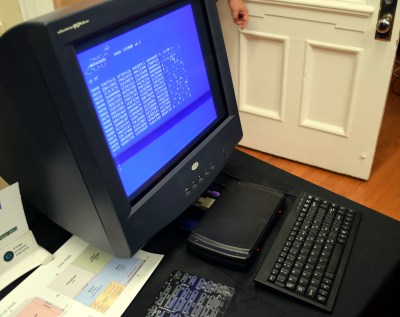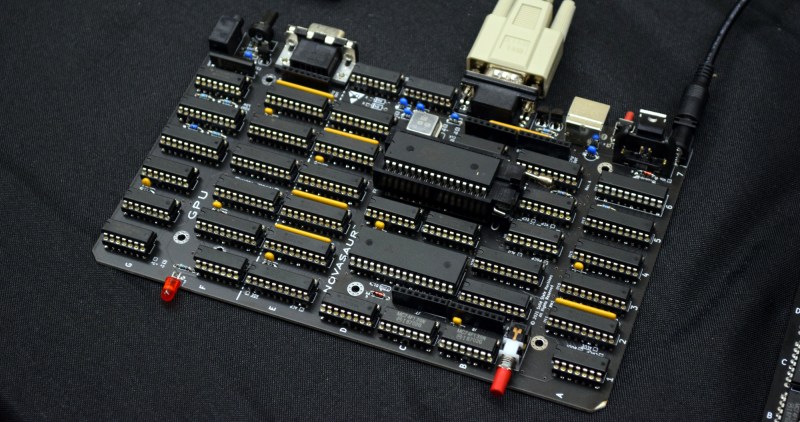There was certainly no shortage of unique computers on display at the 2021 Vintage Computer Festival East; that’s sort of the point. But even with the InfoAge Science and History Museum packed to the rafters with weird and wonderful computing devices stretching back to the very beginning of the digital age, Alastair Hewitt’s Novasaur was still something of an oddity.
In fact, unless you knew what it was ahead of time, you might not even recognize it as a computer. Certainly not a contemporary one, anyway. There’s nothing inside its Polycase ZN-40 enclosure that looks like a modern CPU, a bank of RAM, or a storage device. Those experienced with vintage machines would likely recognize the tight rows of Advanced Schottky TTL chips as the makings of some sort of computer that predates the 8-bit microprocessor, but its single 200 mm x 125 mm (8 in x 5 in) board seems far too small when compared to the 1970s machines that would have utilized such technology. So what is it?
Inspired by projects such as the Gigatron, Alastair describes the Novasaur as a “full-featured personal computer” built using pre-1980 components. In his design, 22 individual ICs stand in for the computer’s CPU, and another 12 are responsible for a graphics subsystem that can push text and bitmapped images out over VGA at up to 416 x 240. It has 512 K RAM, 256 K ROM, and is able to emulate the Intel 8080 fast enough to run CP/M and even play some early 80s PC games.
Better Living Through Emulation
Arguably the most noteworthy feature of the Novasaur is it’s ability to emulate a vintage CPU. By taking this approach, Alastair essentially ensured that the only software he’d ever technically have to write for the computer would be a hardware abstraction layer. Once that was in place, he could simply load up existing programs and operating systems that were designed to run on the emulated chip.
Generally speaking, TTL computers need to have new applications written for them. To use the Gigatron as an example, the system’s ROM provides the user with a handful of tools and games that were written specifically for the hardware. But outside of that, your best bet for getting new software on the system would be to use the Tiny BASIC interpreter and write it yourself.

It would be almost a year later before he made a post explaining his decision to target the relatively overlooked RCA 1802 COSMAC. A month later, at the recommendation of Gigatron’s creator Marcel van Kervinck, he reevaluated the situation once more. Originally he’d been put off by the complexity of the Z80, but the Intel 8080 seemed to offer a reasonable middle-ground. As it takes his computer 137 cycles to complete one CPU instruction, Alastair says the final emulated CPU is operating at approximately 450 kHz, or around 22% as fast as the original hardware.
Living History
 While the Novasaur is an incredible accomplishment itself, one also has to give credit to Alastair for the phenomenal documentation he’s put together. Since the beginning of 2019, he’s been documenting every step that’s gone into the planning, design, and construction of his TTL computer through log updates on the Hackaday.io page.
While the Novasaur is an incredible accomplishment itself, one also has to give credit to Alastair for the phenomenal documentation he’s put together. Since the beginning of 2019, he’s been documenting every step that’s gone into the planning, design, and construction of his TTL computer through log updates on the Hackaday.io page.
The fact that we can look back and see exactly what promoted him to switch gears and start focusing on Intel 8080 compatibility or what it looked like the first time the graphics system lit up a real CRT display, is an invaluable resource for others who might be working on similar systems. Of course even if you’re not looking to build a TTL computer of your own, it’s still fascinating to see how it all came together.
There’s some irony that, even though it was on display at the Vintage Computer Festival, the Novasaur was almost certainly one of the newest pieces of hardware in the building. After all, the PCB just hit its final (for now, at least) revision over the summer. Even still, there were few other machines that felt as truly personal as this labor of love, and I’m glad that VCF not only gave me the chance to see it up-close, but to meet its exceptionally passionate creator.

















Now to hook it up to a mouse using the info in last week’s HaD article!
B^)
sure, sure. then you’d expect it to run GSX.
What a beauty, you can tell that’s a man with pride in his work. Wonder if we’ll be able to buy this in kit form at some point?
His build log/blog says this near the very top (last entry):
“A limited number of Rev. 9 PCBs were given out at VCF West and it looks like these will be very close to the final Rev. A release.”
I don’t know about a kit, per se, but he apparently at least plans to make the PCB available in some form (as opposed to being a one-off project).
Did he emulate the 8080 CPU in hardware or software? I’m confused because of this statement:
“Arguably the most noteworthy feature of the Novasaur is it’s ability to emulate a vintage CPU. By taking this approach, Alastair essentially ensured that the only software he’d ever technically have to write for the computer would be a hardware abstraction layer. Once that was in place, he could simply load up existing programs and operating systems that were designed to run on the emulated chip.”
Didn’t he have to write the emulation software also?
I’m not certain, but it looks like it would have to be software emulation. The block diagram is unlike an 8080. There is a lot of ROM used, so I suppose the emulation could be in ROM, which would make it firmware.
By the schematic (which isn’t giving a lot of clues – not even IC descriptions) it seems that it’s FLASH stored microcode. Note: Schematic shows EPROM but picture shows FLASH fitted.
That’s probably also the speed bottleneck. The SRAM in the picture is 55ns access. As it’s synchronously symmetrical, I assume the FLASH is also 55ns.
You really can’t get FLASH (or other technologies) in DIP any lower than 55ns and that’s the speed bottleneck if you want to keep the “DIP” aesthetic.
It’s easy to get DIP SRAM in higher speeds.
Perhaps a solution is to shadow the FLASH into faster SRAM before running. The rest of the circuit is capable of running much faster.
The “official” ROM is the AT27C020 since it’s the only DIP of that size that goes down to 55ns. Luckily the 70ns NOR flash chips operate closer to 35ns and I can use those for development without burning though OTP parts. The 55ns SRAM is definitely one of the bottlenecks. There’s a couple of other places in the instruction decode path that limit the rest of the system to around a 50ns cycle, so there’s not much gain from faster memories.
It’s software emulation. Almost everything is bit-banged with critical timing constraints, so you can’t yield to a user’s program. The firmware is written to break everything up in to 43 cycle sequences. A lookup table is used to determine what to do next at the end of each sequence – update video state, output audio, sample serial, or fetch/execute 8080 machine code.
The hardware abstraction layer is the emulator. It is a Harvard architecture. So the emulator is central to his ROM.
Synthesize it in an foga, see how fast you can clock it. Emulate an 8080 at 50+MHz. :)
That sounds like a goo0d idea. But first I will have to learn FHDL (Foga Hardware Definition Language) to be able to program the FOGA chips. Shoudn’t be to hard.